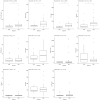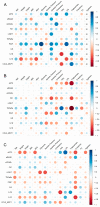Stratification of Patients with Coronary Artery Disease by Circulating Cytokines Profile: A Pilot Study
- PMID: 37892788
- PMCID: PMC10607348
- DOI: 10.3390/jcm12206649
Stratification of Patients with Coronary Artery Disease by Circulating Cytokines Profile: A Pilot Study
Abstract
Coronary artery disease (CAD) is a long-term inflammatory process, with atherosclerosis as its underlying pathophysiological mechanism. Endothelial dysfunction is the first step towards atherosclerosis, where damaged endothelial cells release large amounts of pro-inflammatory cytokines and mediators, thus promoting vascular inflammation and disease progression. However, the correlation between serum cytokines and CAD severity remains to be defined. Serum samples from patients performing cardiac computed tomography for suspected CAD (n = 75) were analyzed with a multiplex bead-based immunoassay panel for simultaneous assessment of the concentration of 11 cytokines using flow cytometric technology. The analysis showed statistically significant increases in sRAGE, CCL2_MCP1, FLT1, and IL6 levels in CAD patients compared with healthy subjects and a gradual increase trend towards a more severe form of the disease for most cytokines (e.g., sCD40L, FLT1, sRAGE, CCL2-MCP1, TNFα). Lastly, we explored the performance of cytokines in predicting the diagnosis of CAD and found that an increase in IL6 levels will increase the odds of being non-obstructive CAD-positive. In contrast, an increase in CCL2-MCP1 or FLT1 levels will increase the probability of being obstructive CAD-positive. These results suggest that the combination of serum cytokines may contribute to the not-invasive stratification risk for patients with suspected CAD.
Keywords: cardiovascular disease; coronary artery disease; diagnostic markers; inflammation cytokines.
Conflict of interest statement
The authors declare that the research was conducted in the absence of any commercial or financial relationships that could be construed as a potential conflict of interest.
Figures





Similar articles
-
Single photon emission computed tomography for the diagnosis of coronary artery disease: an evidence-based analysis.Ont Health Technol Assess Ser. 2010;10(8):1-64. Epub 2010 Jun 1. Ont Health Technol Assess Ser. 2010. PMID: 23074411 Free PMC article.
-
Serum Cytokines Predict the Severity of Coronary Artery Disease Without Acute Myocardial Infarction.Front Cardiovasc Med. 2022 May 16;9:896810. doi: 10.3389/fcvm.2022.896810. eCollection 2022. Front Cardiovasc Med. 2022. PMID: 35651907 Free PMC article.
-
Cardiac magnetic resonance imaging for the diagnosis of coronary artery disease: an evidence-based analysis.Ont Health Technol Assess Ser. 2010;10(12):1-38. Epub 2010 Jun 1. Ont Health Technol Assess Ser. 2010. PMID: 23074389 Free PMC article.
-
Critical appraisal of inflammatory markers in cardiovascular risk stratification.Crit Rev Clin Lab Sci. 2014 Oct;51(5):263-79. doi: 10.3109/10408363.2014.913549. Epub 2014 Jun 11. Crit Rev Clin Lab Sci. 2014. PMID: 24918900 Review.
-
Quantitative PET/CT measures of myocardial flow reserve and atherosclerosis for cardiac risk assessment and predicting adverse patient outcomes.Curr Cardiol Rep. 2013 Mar;15(3):344. doi: 10.1007/s11886-012-0344-0. Curr Cardiol Rep. 2013. PMID: 23397541 Review.
Cited by
-
An overview of Synlab SDN Biobank's quality control system.Sci Rep. 2024 Aug 20;14(1):19303. doi: 10.1038/s41598-024-70263-3. Sci Rep. 2024. PMID: 39164464 Free PMC article.
-
Differential Ophthalmological Profile in Patients with Coronary Artery Disease Coexisting with Type 2 Diabetes Mellitus: Elevated Tear Cytokine Concentrations.J Clin Med. 2024 Aug 20;13(16):4906. doi: 10.3390/jcm13164906. J Clin Med. 2024. PMID: 39201047 Free PMC article.
-
Lymphocyte Subset Imbalance in Cardiometabolic Diseases: Are T Cells the Missing Link?Int J Mol Sci. 2025 Jan 21;26(3):868. doi: 10.3390/ijms26030868. Int J Mol Sci. 2025. PMID: 39940640 Free PMC article. Review.
References
LinkOut - more resources
Full Text Sources
Miscellaneous

